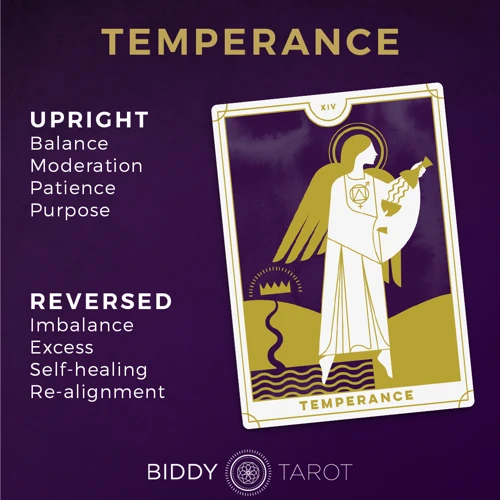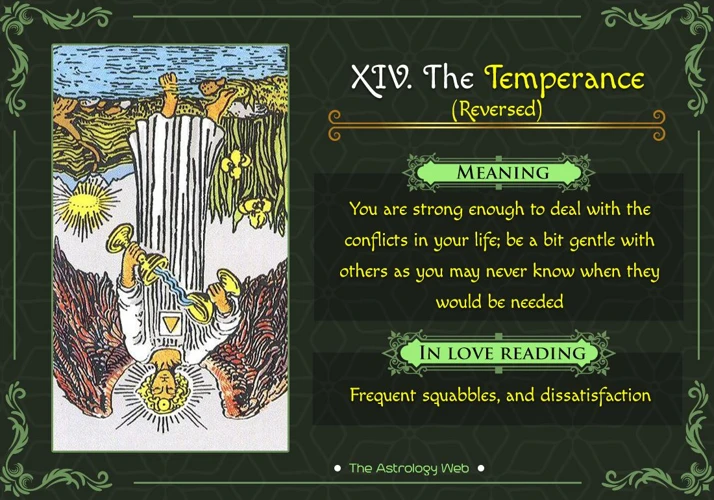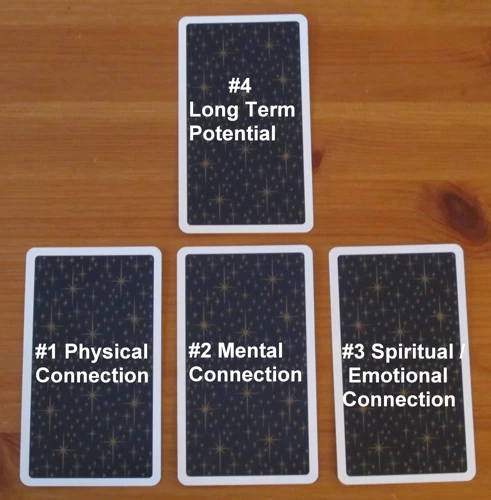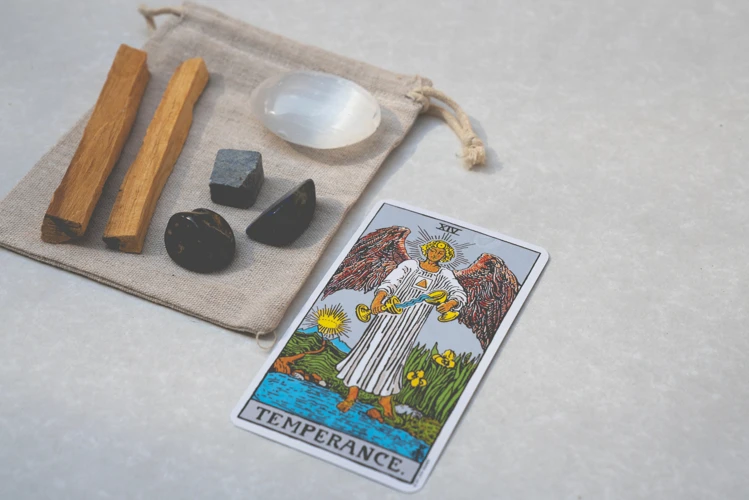In the fast-paced and often chaotic world we live in, finding harmony, balance, and moderation can feel like an elusive quest. However, the Temperance card, with its deep symbolism and profound meaning, offers a guide to navigating life’s challenges with grace and equilibrium. Whether it’s in our relationships, career, finances, mental and emotional well-being, or even our spiritual journey, the Temperance card teaches us the art of blending opposing forces to find harmony and inner peace. In this article, we will explore the rich symbolism of the Temperance card and delve into practical ways to interpret its messages in various aspects of our lives. So, let us embark on this journey of self-discovery and learn how to embrace the essence of the Temperance card to find serenity amidst the chaos.
Contents
- The Meaning of the Temperance Card
- Symbolism and Interpretation
- How to Interpret the Temperance Card in Readings
- Finding Harmony in Relationships
- Discovering Balance in Career and Finances
- Seeking Mental and Emotional Stability
- Embracing Moderation in Health and Well-being
- Finding Spiritual Harmony and Inner Peace
- Conclusion
-
Frequently Asked Questions
- 1. What does the Temperance card symbolize in tarot readings?
- 2. How can I interpret the angel on the Temperance card?
- 3. What do the cups on the Temperance card represent?
- 4. What is the significance of the flowing water in the Temperance card?
- 5. How can I apply the lessons of the Temperance card in my relationships?
- 6. What does the Temperance card teach us about career and finances?
- 7. How can the Temperance card help with managing stress and anxiety?
- 8. What role does the Temperance card play in maintaining a healthy lifestyle?
- 9. Can the Temperance card assist in finding spiritual harmony?
- 10. How can the lessons of the Temperance card enhance our overall well-being?
- References
The Meaning of the Temperance Card

The Temperance card is a powerful symbol of balance, harmony, and moderation in life. Represented by an angelic figure pouring water between two cups, this card teaches us the importance of finding a middle ground and blending opposing energies. The angel on the card serves as a reminder of our connection to the spiritual realm and the need to integrate our higher selves into our daily lives. The cups symbolize emotions, and the flowing water symbolizes the flow of energy and emotions. The Temperance card encourages us to find balance and moderation in our emotions and actions, avoiding extremes and finding a sense of equilibrium. It reminds us that patience and moderation can lead to greater harmony and fulfillment in our lives. The Temperance card is associated with the zodiac sign Sagittarius, which further emphasizes the need for balance and moderation. When this card appears in a reading, it often indicates a need to find balance in a specific area of our lives or to seek a moderate approach to a situation. By embracing the lessons of the Temperance card, we can discover a sense of inner peace and navigate life’s challenges with grace and tranquility.
Internal link: Strength card.
Symbolism and Interpretation

The symbolism of the Temperance card holds deep meaning that invites us to explore its intricate layers of interpretation. At the forefront of this card is the angelic figure, serving as a bridge between the physical and spiritual realms. With one foot on land and one in water, the angel represents the harmonious integration of opposing forces. The cups in the angel’s hands symbolize emotions and intuition, while the flowing water signifies the fluidity of energies and the need for adaptability. The act of pouring water from one cup to another demonstrates the importance of finding balance and moderation in our emotional lives. The Temperance card encourages us to embrace patience, self-control, and a temperate approach to situations. It assures us that by seeking middle grounds and avoiding extremes, we can find harmony and serenity in our lives. The angel’s wings symbolize divine protection, and the crown on the angel’s head signifies spiritual enlightenment and connection to higher powers. The Temperance card invites us to trust the process, remain open to spiritual guidance, and actively seek balance in all aspects of our lives.
Internal link: The Sun card.
1. The Angel
The angel depicted in the Temperance card holds a significant meaning within its symbolism. As a divine messenger, the angel represents our connection to the spiritual realm and the guidance we receive from higher powers. The angel’s presence suggests the need for us to align ourselves with our higher selves and tap into our intuition. This connection with the spiritual realm allows us to gain clarity and insight in navigating life’s challenges. By following our inner guidance, we can make decisions and choices that are in alignment with our highest good. The angel in the Temperance card serves as a reminder for us to listen to our intuition and trust the messages we receive from the divine. This connection to the spiritual realm can guide us on our path of self-discovery and help us find solutions to the dilemmas we face. By embracing the energy of the angel, we can cultivate a deeper understanding of our dreams, intuition, and subconscious. This internal link leads to more information about the Moon card and its significance in uncovering the hidden aspects of our psyche.
2. The Cups
The cups in the Temperance card hold deep symbolic meaning. They represent the realm of emotions and the importance of finding balance within our feelings. The two cups on the card are often depicted as one being filled with water and the other being poured into the first cup. This symbolic act represents the harmonious blending of emotions within ourselves. The filled cup signifies emotional fulfillment and contentment, while the pouring cup represents the integration and balance of our emotions. It reminds us that emotions are fluid and ever-changing, and it is crucial to understand and acknowledge our emotions without getting consumed by them. The cups also symbolize the need for receptivity and openness to the full range of emotions that life presents to us. They remind us that an imbalance in our emotional state can hinder our ability to find true equilibrium and harmony. The Temperance card teaches us to be mindful of our emotional well-being and to strive for emotional balance in all aspects of our lives.
The cups in the Temperance card symbolize emotions, and their representation signifies the need for balance and harmony within our emotional states. By acknowledging and integrating our emotions in a healthy and balanced way, we can find a sense of inner peace and navigate life’s challenges with grace and mindfulness.
3. The Water
In the Temperance card, the water holds significant symbolism and represents the flow of emotions and energy. Water is a vital element that carries with it a sense of fluidity and adaptability. It symbolizes our emotions, intuition, and the subconscious mind. Just like water, our emotions can be gentle and calm or turbulent and overwhelming. The water in the Temperance card reminds us of the importance of finding a balance in our emotions and maintaining a sense of harmony within ourselves. The act of pouring water from one cup to another represents the process of blending and harmonizing different aspects of our emotions and finding equilibrium. It encourages us to be mindful of our emotional state and to navigate the ebb and flow of our feelings with grace and moderation. The water also symbolizes purification and renewal, suggesting that by embracing the lessons of the Temperance card, we can find emotional healing and growth. Additionally, water is associated with intuition and the subconscious mind, reminding us to trust our inner wisdom and listen to the subtle messages that arise from within. Just as water can reflect our innermost emotions, it can also serve as a mirror for our true selves. Through the symbolism of water, the Temperance card encourages us to dive deep within ourselves, explore our emotions, and discover a greater sense of inner peace and wholeness.
How to Interpret the Temperance Card in Readings

When interpreting the Temperance card in readings, it’s important to consider the context of the reading and the surrounding cards. The Temperance card encourages us to find balance, harmony, and moderation in all aspects of our lives. Here are some key points to consider when interpreting this card:
1. Integration: The Temperance card often signifies the need to integrate different elements or aspects of our lives. It calls for a harmonious blend of opposing forces, whether it’s work and play, logic and intuition, or the different areas of our lives such as relationships, career, and personal well-being.
2. Patience: The presence of the Temperance card suggests the importance of patience and taking a long-term view. It reminds us to be patient as we navigate challenges and pursue our goals. It indicates that the desired outcomes may require time, effort, and a steady approach.
3. Balance: The Temperance card urges us to find balance and moderation in our thoughts, actions, and emotions. It encourages us to avoid extremes and find a middle ground that aligns with our values and goals. It reminds us that balance leads to inner peace and overall well-being.
4. Adaptability: The angelic figure on the Temperance card represents adaptability and the ability to flow with change. It suggests that we need to be flexible and adaptable in our approach, allowing for adjustments and finding alternative solutions when needed.
5. Healing: The Temperance card is often associated with healing and transformation. It indicates a need for emotional healing, reconciliation, and finding resolution in challenging situations. It reminds us to approach conflicts with compassion and forgiveness.
The Temperance card brings a message of finding harmony and balance in our lives. It encourages us to embrace moderation and integrate different aspects of our being to achieve a sense of wholeness and fulfillment.
Finding Harmony in Relationships

Finding harmony in relationships is an essential aspect of leading a fulfilling life. It involves cultivating a sense of balance, understanding, and mutual respect with our loved ones. To achieve this, it is important to focus on a few key elements. Firstly, balancing give and take is crucial. Relationships thrive when there is an equitable distribution of love, support, and compromise between all parties involved. Effective communication is another vital component. By openly expressing our needs, concerns, and aspirations, we create a space for understanding and compromise. Additionally, setting clear boundaries is essential in maintaining a healthy relationship. This involves recognizing and respecting each individual’s needs for personal space, privacy, and emotional well-being. By continuously working on these aspects, we can foster harmonious and fulfilling connections with our loved ones.
1. Balancing Give and Take
Balancing give and take is a fundamental aspect of maintaining harmony in relationships. When it comes to interpersonal connections, it is crucial to strike a balance between our own needs and the needs of others. This means being able to give and receive in equal measure. The Temperance card reminds us of the importance of finding this equilibrium in our interactions with others. It encourages us to cultivate empathy and compassion, recognizing that healthy relationships thrive on reciprocity. Balancing give and take involves not only being considerate and supportive of others but also setting boundaries and asserting our own needs. It is about finding a middle ground where both parties feel heard and valued. This can be achieved through open communication and a willingness to compromise. When we achieve a harmonious balance of give and take, we create a foundation of trust and mutual respect in our relationships. This allows for a deeper connection and greater emotional fulfillment. By embracing the lessons of the Temperance card in this aspect of our lives, we can foster healthier and more satisfying relationships with those around us.
2. Communication and Compromise
Communication and compromise are essential components of finding harmony in relationships. When it comes to maintaining healthy and balanced connections with others, effective communication is key. Honest and open communication allows us to express our needs and desires while also listening attentively to the needs of our partners, friends, or family members. By actively listening and responding with empathy, we can foster better understanding and create an atmosphere of trust and respect. Compromise also plays a crucial role in creating harmony in relationships. It involves finding common ground and reaching agreements that satisfy both parties involved. This requires a willingness to let go of the need to always be right and to consider the perspectives and desires of others. By finding a middle ground through compromise, we can ensure that both parties feel heard and valued. Ultimately, communication and compromise are essential tools for maintaining balance and harmony in our relationships, promoting understanding, and fostering healthy connections.
3. Creating Boundaries
3. Creating Boundaries
Creating boundaries is an essential aspect of finding harmony in relationships. Boundaries serve as guidelines for acceptable behavior and help maintain a healthy balance in relationships. When it comes to the Temperance card, creating boundaries involves knowing our limits and understanding what we are willing to give and receive in relationships. Here are three important aspects to consider when it comes to creating boundaries:
1. Communicating Expectations: Open and honest communication is key in establishing boundaries. Clearly express your needs, desires, and expectations in a relationship. By setting clear boundaries and discussing them with your partner, you can avoid misunderstandings and conflicts.
2. Respecting Personal Space: Each individual needs their own personal space and time. By respecting and honoring each other’s personal space, you are creating a healthy and balanced dynamic in the relationship. This includes allowing time for self-care, pursuing individual hobbies, and spending time with friends and family.
3. Saying No When Necessary: It’s important to know when to say no and set boundaries for what you are comfortable with. This might mean saying no to requests that go against your values or boundaries. Remember, saying no is an act of self-care and self-respect.
Creating boundaries in relationships promotes a sense of respect and self-worth. It allows for mutual growth and understanding while fostering a healthy balance between giving and receiving. By establishing clear boundaries, we create an environment where both individuals can thrive and contribute positively to the relationship.
- Communicating Expectations: Open and honest communication is key in establishing boundaries. Clearly express your needs, desires, and expectations in a relationship.
- Respecting Personal Space: Each individual needs their own personal space and time. By respecting and honoring each other’s personal space, you are creating a healthy and balanced dynamic in the relationship.
- Saying No When Necessary: It’s important to know when to say no and set boundaries for what you are comfortable with. This might mean saying no to requests that go against your values or boundaries.
Discovering Balance in Career and Finances

Discovering balance in our career and finances is essential for maintaining a sense of stability and fulfillment in our lives. To achieve this, there are several key principles to consider. First, establishing work-life balance is crucial to avoid burnout and promote overall well-being. This involves setting boundaries between work and personal life, prioritizing self-care, and allocating time for leisure and relaxation. Second, managing finances responsibly is vital for maintaining financial stability and reducing stress. This includes creating a budget, tracking expenses, and saving for the future. Additionally, setting realistic goals helps to maintain a healthy balance in our career and finances. It is important to have aspirations and ambitions but also to be mindful of our limitations and embrace a gradual approach towards success. By adhering to these principles, we can find equilibrium in our professional and financial endeavors, leading to a more harmonious and fulfilling life.
1. Establishing Work-Life Balance
1. Establishing Work-Life Balance
Work-life balance is essential for our overall well-being and happiness. Here are some practical steps you can take to establish a healthy work-life balance:
– Prioritize: Identify your priorities in both your professional and personal life. Determine what matters most to you and allocate your time and energy accordingly. Remember, it’s not about trying to achieve a perfect balance every day, but about making conscious choices that align with your values and goals.
– Set Boundaries: Clearly define your boundaries between work and personal life. Communicate these boundaries to your colleagues, clients, and loved ones. Establish designated work hours and create a space where you can disconnect from work-related matters outside of those hours. By setting boundaries, you create a structure that allows you to focus on different aspects of your life without feeling overwhelmed.
– Practice Self-Care: Take care of yourself physically, mentally, and emotionally. Engage in activities that bring you joy and relaxation outside of work. Whether it’s exercise, hobbies, spending time with loved ones, or simply taking quiet moments for yourself, make self-care a priority. Nurturing yourself allows you to recharge and bring your best self to both your work and personal life.
– Delegate and Seek Support: Recognize that you don’t have to do everything on your own. Delegate tasks when possible, whether it’s at work or at home. Seek support from colleagues, friends, or family members when needed. Asking for help not only lightens the load but also allows others to contribute and strengthens bonds.
– Nurture Relationships: Take time to nurture your relationships with loved ones. Schedule quality time with family and friends, and be fully present during those moments. Building and maintaining strong relationships outside of work is crucial for a healthy work-life balance.
Remember, achieving work-life balance is an ongoing process and may require adjustments along the way. By implementing these strategies, you can create a harmonious integration of your work and personal life, leading to greater satisfaction and overall well-being.
Internal link: Moon card.
2. Managing Finances Responsibly
Managing finances responsibly is an essential aspect of finding balance and harmony in life. When it comes to our financial well-being, the Temperance card advises us to approach money and resources with moderation and prudence. It urges us to create a healthy and sustainable relationship with our finances. One way to manage finances responsibly is by practicing budgeting and wise spending habits. This involves tracking expenses, setting financial goals, and making informed decisions about how to allocate our income. Embracing a mindset of moderation means avoiding unnecessary debt and living within our means.
Another aspect of responsible financial management is saving and investing. The Temperance card encourages us to find a balance between enjoying the present and planning for the future. By setting aside a portion of our income for savings and investments, we create financial stability and have the opportunity to grow our wealth over time. This can provide a sense of security and enable us to pursue our dreams and aspirations.
Managing finances responsibly involves being mindful of our financial obligations and honoring our commitments. This includes paying bills on time, managing debt effectively, and maintaining a good credit history. It is important to find a balance between enjoying the present and being responsible for our financial obligations.
By practicing responsible financial management, we can alleviate stress and worries related to money, allowing us to focus on other aspects of our lives. The Temperance card reminds us that finding harmony in our financial affairs contributes to overall well-being and can lead to a greater sense of peace and stability.
Internal link: Sun card.
3. Setting Realistic Goals
Setting realistic goals is a crucial aspect when it comes to finding balance and moderation in our career and finances. It’s easy to get caught up in the pressure of achieving grandiose dreams or comparing ourselves to others’ success, but setting unrealistic expectations can lead to stress, burnout, and financial instability. When we learn to set realistic goals, we create a solid foundation for sustainable growth and fulfillment. Realistic goals are those that align with our capabilities, resources, and values. They take into consideration our current circumstances and allow for steady progress over time. By setting realistic goals, we avoid the pitfalls of overextending ourselves or setting unattainable standards. It’s important to assess our skills and resources objectively, and to break down our goals into smaller, achievable milestones. This approach allows us to make steady progress while enjoying a sense of accomplishment along the way. Additionally, setting realistic goals helps us maintain a healthy work-life balance, as we don’t become consumed by an unattainable pursuit of success. Ultimately, by setting realistic goals, we can find satisfaction and fulfillment in our careers and finances while maintaining a sense of harmony and balance in our lives.
Seeking Mental and Emotional Stability

Seeking mental and emotional stability is crucial for overall well-being and personal growth. In our fast-paced and often stressful lives, it can be challenging to maintain a sense of calm and balance. However, there are practical steps we can take to cultivate mental and emotional stability. First, managing stress and anxiety is vital. This can be achieved through various techniques such as deep breathing exercises, mindfulness meditation, and engaging in activities that bring joy and relaxation. Practicing self-care regularly is another essential aspect of seeking stability. This includes carving out time for activities that promote mental and emotional well-being, such as journaling, spending time in nature, or engaging in hobbies. Embracing change with grace is also crucial, as life is constantly evolving, and learning to adapt to new situations can help reduce stress and cultivate emotional stability. By acknowledging and accepting our emotions, setting healthy boundaries, and seeking support when needed, we can navigate the ups and downs of life with resilience and find greater mental and emotional stability.
1. Managing Stress and Anxiety
Managing stress and anxiety is crucial for maintaining mental and emotional well-being. When it comes to finding harmony and balance in our lives, it is important to address and manage these common challenges.
1. Practice Mindfulness: Incorporating mindfulness techniques into your daily routine can significantly reduce stress and anxiety. Set aside a few minutes each day to engage in activities such as meditation, deep breathing exercises, or journaling. These practices help to calm the mind, bring awareness to the present moment, and promote a sense of peace and tranquility.
2. Seek Support: Don’t be afraid to reach out to loved ones, friends, or professionals when dealing with stress and anxiety. Sharing your feelings and concerns with others can provide you with a different perspective and help you find effective coping strategies. Additionally, therapists or counselors can provide guidance and tools to manage and overcome these challenges.
3. Engage in Self-Care: Taking care of your physical, emotional, and mental well-being is essential for managing stress and anxiety. Prioritize activities that bring you joy and relaxation, such as exercising, practicing hobbies, or enjoying a spa day. Nurturing yourself allows you to recharge and better cope with the demands of life.
4. Develop Healthy Coping Mechanisms: Find healthy and productive ways to cope with stress and anxiety, as opposed to relying on unhealthy habits or behaviors. This could include engaging in regular exercise, practicing deep breathing exercises, or engaging in creative outlets such as painting or playing music. By developing positive coping mechanisms, you can effectively manage stress and anxiety while fostering a sense of balance and well-being.
Remember, managing stress and anxiety is an ongoing process, and it may require a combination of techniques to find what works best for you. By prioritizing your mental and emotional health, you can cultivate a greater sense of harmony and balance in your life.
2. Cultivating Mindfulness and Self-Care
Cultivating mindfulness and practicing self-care are essential components of finding harmony and balance in life. Mindfulness involves being fully present in the moment, consciously aware of our thoughts, feelings, and sensations without judgment. By incorporating mindfulness into our daily routine, we can become more attuned to ourselves and better equipped to navigate the challenges that arise. This can be done through practices such as meditation, breathing exercises, or simply taking moments throughout the day to pause and check in with ourselves.
Self-care is the act of intentionally taking care of our physical, mental, and emotional well-being. It involves prioritizing activities that nourish and replenish us, such as engaging in hobbies, spending time in nature, or seeking support from loved ones. By making self-care a priority, we can recharge our energy reserves and prevent burnout. It’s important to remember that self-care looks different for everyone, and it’s crucial to find practices that resonate with our individual needs and preferences.
To cultivate mindfulness and practice self-care, it can be helpful to establish a daily routine that incorporates activities that promote relaxation, self-reflection, and self-nurturing. This can include setting aside time for meditation or journaling, engaging in gentle physical exercise like yoga or walking in nature, or even simply sitting quietly with a cup of tea and allowing ourselves to unwind.
By prioritizing mindfulness and self-care, we can enhance our overall well-being and create a greater sense of balance and harmony in our lives. These practices allow us to recharge, gain perspective, and develop a deeper connection with ourselves. By taking the time to cultivate mindfulness and practice self-care, we are better equipped to handle life’s challenges with grace and find a sense of inner peace.
No relevant anchor text was found in this section.
3. Embracing Change with Grace
Embracing change with grace is a key aspect of finding mental and emotional stability in life. The Temperance card teaches us the importance of adapting to new circumstances and flowing with the ever-changing currents of life. Change can be unsettling and challenging, but by approaching it with grace, we can transform it into an opportunity for growth and self-discovery. Embracing change with grace involves being open-minded and flexible, letting go of resistance and surrendering to the natural flow of life. It requires us to be present in the moment, accepting what is and trusting that everything is unfolding as it should. This doesn’t mean that we have to passively accept every change that comes our way, but rather to approach it with a mindset of curiosity and resilience. By embracing change with grace, we can navigate transitions more smoothly, reducing stress and anxiety. It allows us to let go of what no longer serves us and make room for new beginnings and possibilities. Ultimately, embracing change with grace is an act of self-love and empowerment, as it allows us to step into the unknown with confidence and trust in ourselves and the universe.
Embracing Moderation in Health and Well-being

Embracing moderation in health and well-being is crucial for maintaining a balanced and sustainable lifestyle. This involves nurturing a balanced diet that includes a variety of nutrient-rich foods, while avoiding excessive indulgences that may compromise our overall well-being. Prioritizing regular exercise and adequate rest is also essential for achieving optimal physical health. Finding a balance between pushing ourselves to stay active and allowing our bodies time to recover is key. It is important to remember that moderation extends beyond the physical realm; mental and emotional well-being should also be given attention. Managing stress and anxiety, cultivating mindfulness, and practicing self-care are all important aspects of maintaining a healthy state of mind. By embracing moderation in our health and well-being, we can achieve a state of equilibrium that allows us to thrive both physically and mentally.
1. Nurturing a Balanced Diet
Nurturing a balanced diet is crucial for our overall health and well-being. It involves consuming a variety of nutrient-rich foods in the right proportions to meet our body’s needs. A balanced diet should include a combination of fruits, vegetables, whole grains, lean proteins, and healthy fats. Fruits and vegetables provide essential vitamins, minerals, and antioxidants that support our immune system and help prevent chronic diseases. Whole grains like oats, quinoa, and brown rice provide fiber, which aids in digestion and supports heart health. Lean proteins such as chicken, fish, tofu, and legumes are essential for building and repairing tissues. Healthy fats found in avocados, nuts, and olive oil contribute to brain health and help in the absorption of fat-soluble vitamins. It’s important to moderate our intake of processed foods, sugary snacks, and excessive salt. Incorporating portion control is also essential to maintain a balanced diet. By nourishing our bodies with a variety of wholesome foods, we can promote optimal physical health and energy levels.
Internal link: Strength card.
2. Prioritizing Exercise and Rest
When it comes to finding balance in our health and well-being, prioritizing exercise and rest is crucial. Regular physical activity helps maintain a healthy body and mind, while adequate rest and relaxation enable our bodies to recharge and rejuvenate. Exercise allows us to release stress, improve our mood, increase our energy levels, and enhance our overall physical well-being. It can be as simple as going for a brisk walk, practicing yoga, or engaging in a favorite sport or activity. Regular exercise also promotes better sleep, which is essential for our overall health. Rest, on the other hand, is equally important. It allows our bodies to heal, recover, and restore balance. Prioritizing rest means setting aside time for quality sleep, as well as periods of relaxation throughout the day. This can involve taking short breaks during work or engaging in activities that help us unwind, such as reading, meditating, or enjoying a hobby. By giving equal importance to exercise and rest, we create a harmonious routine that supports our physical and mental well-being. Let us remember that finding balance requires us to listen to our bodies and give them the care they need.
3. Avoiding Excessive Indulgences
3. Avoiding Excessive Indulgences
In the pursuit of balance and moderation, it is important to recognize the potential pitfalls of excessive indulgence. While it is perfectly fine to indulge in life’s pleasures occasionally, overindulgence can lead to negative consequences for our health and overall well-being. One way to avoid excessive indulgences is by practicing self-discipline and setting boundaries. This means being mindful of our consumption of food, drinks, and other indulgences that can be detrimental to our physical and mental health. It can be helpful to create a plan or set limits for ourselves, such as only enjoying treats in moderation or setting specific days for indulgence. Additionally, cultivating awareness of our triggers and vulnerabilities can help us make conscious choices and avoid falling into patterns of excessive indulgence. By practicing self-control and being mindful of our actions, we can maintain a healthy balance and avoid the negative consequences of excessive indulgence.
Here is an example of an html list to present the information concisely:
- Practice self-discipline: Set boundaries and be mindful of your consumption.
- Create a plan: Set limits and specific days for indulgence.
- Cultivate awareness: Recognize your triggers and vulnerabilities.
- Exercise self-control: Make conscious choices to maintain balance.
Finding Spiritual Harmony and Inner Peace
Finding spiritual harmony and inner peace is a fundamental aspect of human existence, and the Temperance card offers guidance on this profound journey. To achieve spiritual harmony, it is essential to explore practices such as meditation and mindfulness. These practices allow us to quiet the mind, connect with our inner selves, and cultivate a sense of presence and awareness. By embracing stillness and silence, we create space to listen to our intuition, gain clarity, and find solace in the inherent wisdom within us. Additionally, a connection with higher powers can bring a sense of grounding and guidance. Whether through prayer, ritual, or communing with nature, connecting with something greater than ourselves can provide comfort, inspiration, and a deeper understanding of our purpose. Embracing acceptance and forgiveness is essential in finding spiritual harmony. Letting go of resentments and judgments allows us to release negative energy and make room for love, compassion, and inner peace. By seeking spiritual harmony, we embark on a profound journey of self-discovery and find solace in the interconnectedness of all beings and the vastness of the universe.
Internal link: The Moon card.
1. Exploring Meditation and Mindfulness
Exploring meditation and mindfulness is a powerful practice that can help us find spiritual harmony and inner peace. Meditation involves quieting the mind, focusing on the present moment, and cultivating a sense of inner awareness. It allows us to observe our thoughts and emotions without judgment, promoting a state of calm and tranquility. Mindfulness, on the other hand, involves being fully present and engaged in each moment, paying attention to our thoughts, feelings, and surroundings without distraction. Both practices offer numerous benefits for our mental, emotional, and spiritual well-being. When we engage in regular meditation and mindfulness, we can reduce stress and anxiety, enhance self-awareness, improve concentration, and foster a deep sense of inner calm. These practices also help us detach from negative thoughts and attachments, allowing us to find greater clarity and perspective. By incorporating meditation and mindfulness into our daily lives, we can cultivate a deeper connection with ourselves and the world around us, leading to a more harmonious and fulfilling existence. So, take a moment to sit in stillness, breathe deeply, and embrace the transformative power of meditation and mindfulness in your journey towards inner peace and harmony.
2. Connecting with Higher Powers
Connecting with higher powers is a profound aspect of seeking spiritual harmony and inner peace. There are various practices that can help individuals establish a deeper connection with the divine or their higher selves.
1. Meditation: Meditating regularly allows individuals to quiet their minds and create space for spiritual connection. Whether it is through guided meditation, visualization, or silent reflection, meditation helps to cultivate a sense of peace and stillness that can open the door to higher powers. It allows individuals to tap into their intuition, gain insight and guidance, and experience a sense of unity with the universe.
2. Prayer and Rituals: Engaging in prayer or participating in rituals specific to one’s spiritual beliefs can be a powerful way to connect with higher powers. This can involve expressing gratitude, seeking guidance or support, or engaging in acts of devotion. The act of prayer and rituals offers a channel for individuals to communicate with the divine and foster a deeper connection with their spiritual path.
3. Seeking Knowledge and Wisdom: Exploring spiritual teachings, philosophy, or sacred texts can provide individuals with insights and wisdom from higher powers. This can involve studying ancient spiritual traditions, attending spiritual workshops or retreats, or reading books on spirituality. By seeking knowledge and wisdom, individuals can broaden their perspectives and deepen their understanding of the spiritual realm.
4. Nature and Sacred Spaces: Spending time in nature or visiting sacred sites can be a transformative way to connect with higher powers. Whether it is taking a walk in the woods, sitting by the ocean, or visiting a cathedral or temple, the serenity and beauty of these places can evoke a sense of awe and reverence. Being in nature or in sacred spaces allows individuals to feel connected to something greater than themselves and experience a profound sense of spiritual harmony.
Connecting with higher powers involves cultivating a sense of openness, mindfulness, and reverence. It is a deeply personal and unique journey that varies from individual to individual. By finding practices and experiences that resonate with one’s own beliefs and values, individuals can establish a deeper connection with higher powers and find a sense of spiritual harmony and inner peace.
3. Embracing Acceptance and Forgiveness
Embracing acceptance and forgiveness is a crucial aspect of finding spiritual harmony and inner peace. The Temperance card teaches us the importance of letting go of resentments and releasing any negative emotions that may be holding us back. It encourages us to practice acceptance of ourselves and others, acknowledging that we are all imperfect human beings on our own unique journeys.
To fully embrace acceptance and forgiveness, we can follow these steps:
1. Reflect on past hurts: Take the time to reflect on any past hurts or grievances that you may be holding onto. Acknowledge the pain they have caused and the impact they have had on your life.
2. Practice self-compassion: Extend compassion to yourself, understanding that it’s normal to experience pain and disappointment. Be gentle with yourself and offer forgiveness for any mistakes you may have made.
3. Let go of expectations: Release any expectations or attachments to how things should have been. This includes letting go of grudges and resentments towards others. Recognize that holding onto these negative emotions only hinders your own growth and inner peace.
4. Cultivate empathy: Try to understand the perspective of others involved in the situation. Recognize that everyone has their own struggles and may have acted out of their own pain or limitations. Extend empathy towards them, allowing for the possibility of healing and reconciliation.
5. Practice forgiveness: Forgiveness is not about condoning the actions of others or forgetting what has transpired. It is a conscious choice to release the negative emotions and resentment associated with the situation. Forgiveness sets us free and allows us to move forward with compassion and love.
By embracing acceptance and forgiveness, we create space for healing and transformation in our lives. We release ourselves from the burden of carrying past hurts and open ourselves up to experiencing peace, joy, and deeper connections with ourselves and others. Remember that the journey towards acceptance and forgiveness may take time, but with patience and practice, it is possible to find solace and freedom within our hearts.
External link: The Moon card.
Conclusion
In conclusion, the Temperance card serves as a gentle reminder to seek harmony, balance, and moderation in every aspect of our lives. By embracing the symbolism and teachings of this card, we can navigate the ups and downs of life with grace and equilibrium. Whether it’s in our relationships, career, finances, mental and emotional well-being, or spiritual journey, the Temperance card guides us towards finding the middle ground and blending opposing forces. It encourages us to communicate and compromise, establish boundaries, manage our time and resources responsibly, prioritize self-care, and embrace change with acceptance. Embracing the essence of the Temperance card not only brings us greater inner peace but also enables us to lead more meaningful and fulfilling lives. So, let us embrace the wisdom of this card and strive to find harmony, balance, and moderation in all that we do.
If you’re interested in exploring more tarot card meanings, be sure to check out articles on The Sun Card, a symbol of joy and success, as well as The Moon Card, which delves into the realms of dreams, intuition, and the subconscious mind.
Frequently Asked Questions
1. What does the Temperance card symbolize in tarot readings?
The Temperance card symbolizes balance, harmony, and moderation in tarot readings. It signifies the need to find a middle ground and blend opposing energies to achieve inner peace and equilibrium.
2. How can I interpret the angel on the Temperance card?
The angel on the Temperance card represents our connection to the spiritual realm and the integration of our higher selves into our daily lives. It serves as a reminder to tap into our inner wisdom and seek guidance from a higher power.
3. What do the cups on the Temperance card represent?
The cups on the Temperance card symbolize emotions and the realm of the unconscious. They represent the need to balance and moderate our emotional experiences and to find harmony between our feelings and actions.
4. What is the significance of the flowing water in the Temperance card?
The flowing water in the Temperance card represents the flow of energy and emotions. It signifies the need to allow our emotions to flow freely but also to maintain a sense of control and moderation. It reminds us to go with the natural rhythm of life.
5. How can I apply the lessons of the Temperance card in my relationships?
In relationships, the Temperance card teaches us to find balance by balancing give and take, practicing effective communication and compromise, and setting healthy boundaries. It encourages us to seek harmony in our interactions with others.
6. What does the Temperance card teach us about career and finances?
The Temperance card reminds us to establish work-life balance, manage finances responsibly, and set realistic goals in our career and financial endeavors. It encourages us to find harmony between our professional and personal lives.
7. How can the Temperance card help with managing stress and anxiety?
The Temperance card encourages us to manage stress and anxiety by practicing mindfulness, self-care, and embracing change with grace. It reminds us to find inner peace and stability amidst life’s challenges.
8. What role does the Temperance card play in maintaining a healthy lifestyle?
The Temperance card guides us to nurture a balanced diet, prioritize exercise and rest, and avoid excessive indulgences. It reminds us to find moderation and harmony in our approach to health and well-being.
9. Can the Temperance card assist in finding spiritual harmony?
Yes, the Temperance card can help us find spiritual harmony by exploring practices such as meditation and mindfulness, connecting with higher powers or divine guidance, and embracing acceptance and forgiveness in our spiritual journey.
10. How can the lessons of the Temperance card enhance our overall well-being?
The lessons of the Temperance card enhance our overall well-being by teaching us to find balance and moderation in all aspects of our lives. By embracing harmony and practicing self-care, we can experience greater peace, fulfillment, and a sense of wholeness.






